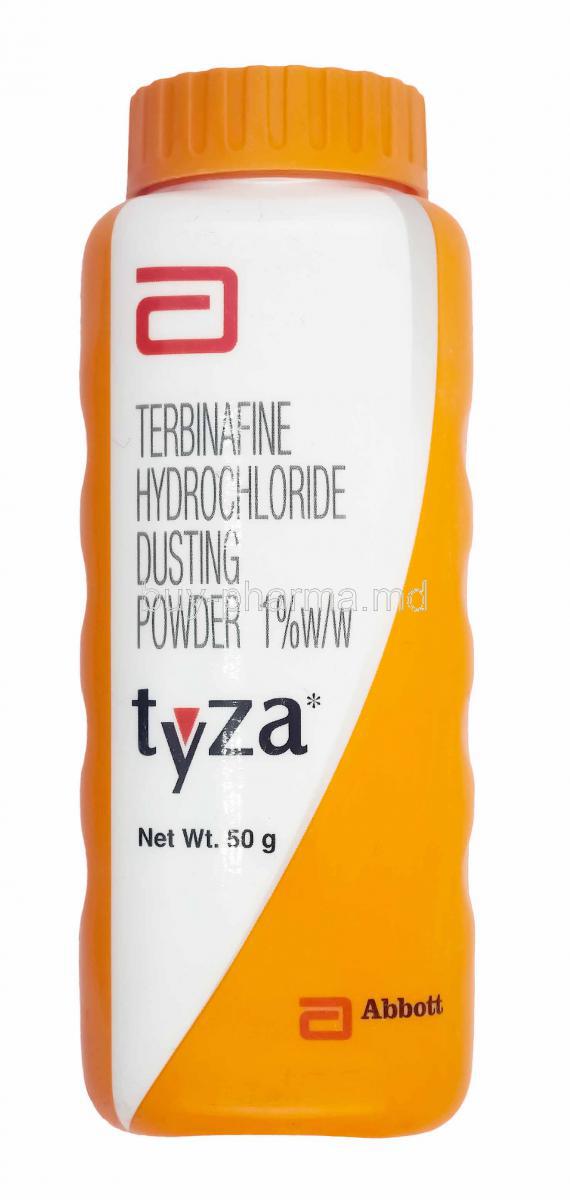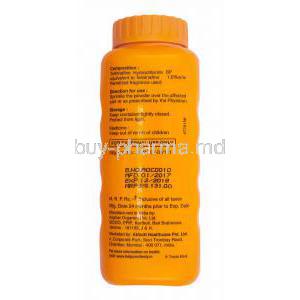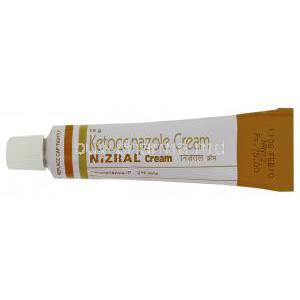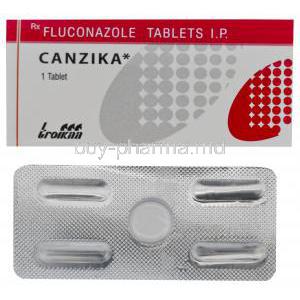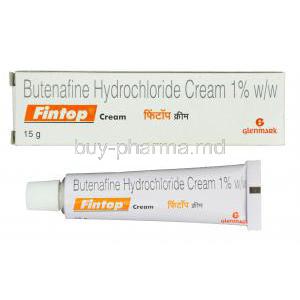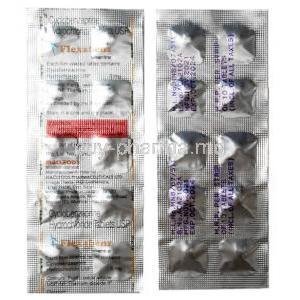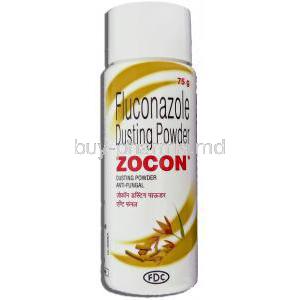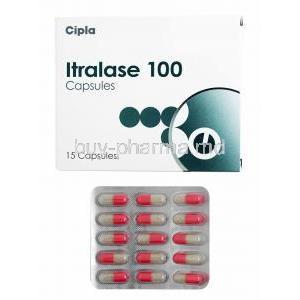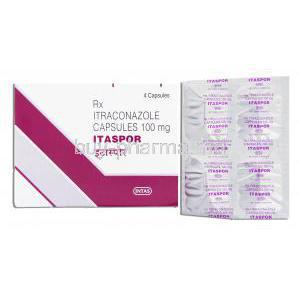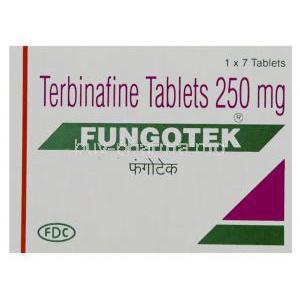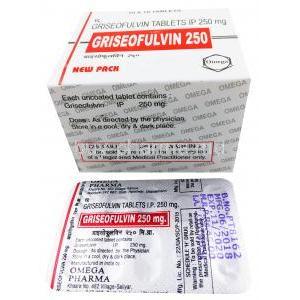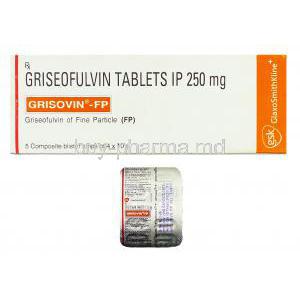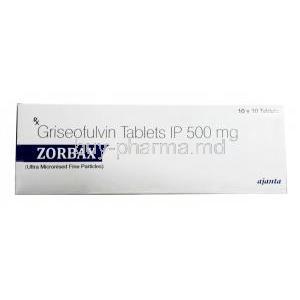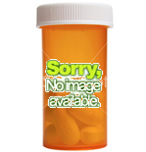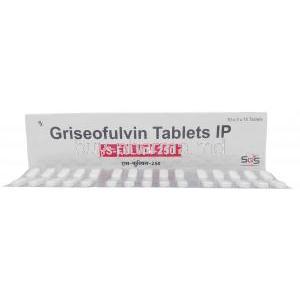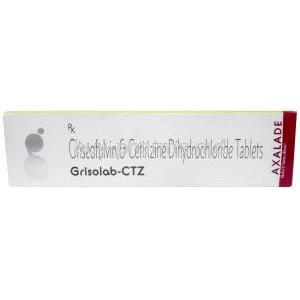Tyza Dusting Powder, Terbinafine
- Introduction
- Composition and Formulation
- Terbinafine Mechanism of Action and How Tyza Dusting Powder Works
- Therapeutic Uses
- Primary Indication: Dermatophytosis (Ringworm, Jock Itch, AthleteâÂÂs Foot)
- Use in Tinea Corporis, Tinea Cruris, and Tinea Pedis
- Role in Prevention of Fungal Recurrence in High-Sweat Areas
- Comparison with Other Antifungal Agents in Powder Form
- Terbinafine for Dogs
- Terbinafine for Cats
- Terbinafine for Toenail Fungus
- Terbinafine for Ringworm
- Terbinafine for Nail Fungus (Onychomycosis)
- Terbinafine for Jock Itch
- Terbinafine for AthleteâÂÂs Foot
- Off-Label Uses
- Terbinafine Dosage and Administration
- Administration in Specific Populations
- Terbinafine Side Effects
- Side Effects of Terbinafine
- Serious or Rare Adverse Effects
- Terbinafine Interactions
- Warnings and Important Precautions
- Contraindications
- Careful Administration
- Overdosage and Management
- Handling and Storage Precautions
- Clinical Pharmacology and Pharmacokinetics
- Patient Counseling Information
- Comparison with Alternative Antifungal Products
- Review
Introduction
Tyza Dusting Powder is a modern, next-generation antifungal treatment primarily used for superficial skin fungi like athlete's foot, jock itch, and ringworm.
As a powder, it works by absorbing moisture, which makes the skin a less favorable environment for fungal growth. This localized treatment is valued for its ability to deliver the drug directly to the affected area while minimizing side effects.
Its active ingredient, terbinafine, was a major breakthrough in antifungal therapy when it was first synthesized in the late 20th century. Terbinafine is powerful, especially against dermatophyte infections, and its unique mechanism of action quickly made it a cornerstone of both topical and oral treatment plans.
Using a dusting powder like Tyza is a good strategy because it creates a protective barrier against recurrent flare-ups, especially helpful for people who sweat heavily or spend time in moisture-trapping environments.
Composition and Formulation
Tyza Dusting Powder is an effective treatment because of its carefully balanced formula, which typically contains 1% w/w Terbinafine Hydrochloride.
Terbinafine, a member of the allylamine family, works by destroying fungal cell membranes. Its unique chemical structure allows it to target a specific enzyme, making it a powerful fungicidal (fungus-killing) drug, unlike many other antifungals that are only fungistatic (growth-inhibiting). Its ability to easily penetrate the skin and remain active for a long time enhances its effectiveness.
The powder also includes ingredients like starch, talc, and magnesium stearate to improve comfort, ensure it spreads easily, and keep it in place. These fillers absorb moisture and reduce friction, which is particularly helpful for skin folds and for extended wear. The powder's light, smooth texture absorbs moisture quickly without clumping or leaving a sticky residue, preventing skin breakdown while still delivering the active drug.
Terbinafine vs. Tolnaftate
Both Terbinafine and Tolnaftate are topical antifungals, but they defeat the fungus differently:
- Terbinafine is fungicidal; it attacks and kills the fungus by blocking the enzyme squalene epoxidase. Patients often see infections clear up faster and have a higher cure rate.
- Tolnaftate is fungistatic; it only stops the fungus from growing and usually requires a longer period of daily use.
In practice, Tolnaftate is often used for general fungal skin issues, while Terbinafine is usually preferred for more difficult-to-clear infections because of its broader and more powerful action.
Terbinafine and Ibuprofen Interaction
It is generally considered safe to use Terbinafine at the same time as taking Ibuprofen. These two medications work through completely different body pathways, and no significant drug-to-drug interactions have been found between them.
Terbinafine Mechanism of Action and How Tyza Dusting Powder Works
The antifungal strength of Tyza Dusting Powder comes from its ability to kill fungi by attacking their cell membranes.
The key mechanism is blocking an enzyme called squalene epoxidase. This enzyme is crucial for making ergosterol, a fat that acts as the cell membrane's structural support in fungi (similar to cholesterol in human cells).
By blocking this enzyme, the active ingredient, terbinafine:
- Stops ergosterol production, causing the fungal membrane to become weak and unstable.
- Causes squalene to build up inside the cell, which is toxic to the fungus.
This double action causes the cell membrane to fall apart, making it leak and ultimately killing the fungus.
Safety and Effectiveness
Terbinafine is highly regarded for its safety because it is a selective toxin: it targets enzymes that exist only in fungi, leaving human cells and their sterol-making process unaffected. This targeted action allows for effective treatment with minimal side effects and irritation.
When using the powder, patients typically notice reduced itching, scaling, and redness within a few days. Because terbinafine remains in the skin tissue for a while, its antifungal effect lasts long after application, helping to prevent the infection from returning. This makes Tyza Dusting Powder a reliable option for both treating and preventing fungal problems.
Therapeutic Uses
Primary Indication: Dermatophytosis (Ringworm, Jock Itch, Athleteâs Foot)
Use in Tinea Corporis, Tinea Cruris, and Tinea Pedis
Role in Prevention of Fungal Recurrence in High-Sweat Areas
Comparison with Other Antifungal Agents in Powder Form
Terbinafine for Dogs
Terbinafine for Cats
Terbinafine for Toenail Fungus
Terbinafine for Ringworm
Terbinafine for Nail Fungus (Onychomycosis)
Terbinafine for Jock Itch
Terbinafine for Athleteâs Foot
Off-Label Uses
Management of Fungal Infections Under Prosthetics or Casts
Adjunctive Use in Onychomycosis Prevention (Nail Infections)
Supportive Care in Hyperhidrosis-Related Fungal Colonization
Preventive Use for Athletes and Patients in Humid Environments
Terbinafine Dosage and Administration
Recommended Frequency and Method of Application
Quantity and Surface Coverage Guidelines for Affected Areas
Duration of Therapy for Various Fungal Infections
Missed Dose Protocol and Treatment Continuity Importance
Terbinafine Dosage for Adults
Administration in Specific Populations
Administration to Elderly Patients
Administration to Pregnant Women and Nursing Mothers
Administration to Children
Terbinafine Side Effects
Overview of Potential Adverse Reactions
Local Irritation, Redness, Burning, and Dryness
Allergic Reactions and Hypersensitivity Response
Side Effects of Terbinafine
Mild Skin Peeling, Dryness, or Itching
Transient Stinging Sensation Upon Application
Localized Rash or Discomfort Resolving With Discontinuation
Serious or Rare Adverse Effects
Signs of Severe Allergic Dermatitis or Angioedema
Contact Urticaria and Secondary Infection Risks
Guidance for Discontinuation and Medical Consultation
Terbinafine Interactions
Interaction With Topical Corticosteroids or Other Antifungals
Cross-Sensitivity With Allylamine Antifungals
Systemic Drug Interaction Risks in Concurrent Oral Terbinafine Therapy
Warnings and Important Precautions
Avoidance of Contact with Eyes, Mucous Membranes, or Open Wounds
Proper Hygiene During and After Application
Risk of Resistance With Improper or Incomplete Use
Precautions for Immunocompromised Patients
Contraindications
Known Hypersensitivity to Terbinafine or Formulation Components
Contraindication in Active Skin Infections Requiring Systemic Therapy
Cases of Severe Dermatitis or Ulcerative Skin Lesions
Terbinafine and Alcohol
Careful Administration
Monitoring for Allergic Reactions in Sensitive Individuals
Caution in Patients With Chronic Dermatologic Conditions
Recommendation for Medical Evaluation if No Improvement Within 2 Weeks
Overdosage and Management
Symptoms of Excessive Application or Misuse
Possible Systemic Absorption Risks and Management Approach
Emergency Procedures for Accidental Ingestion
Handling and Storage Precautions
Optimal Storage Temperature and Humidity Control
Avoidance of Direct Sunlight and Heat Sources
Shelf Life and Packaging Integrity Checks
Proper Disposal of Unused or Expired Powder
Clinical Pharmacology and Pharmacokinetics
Skin Absorption and Local Tissue Concentration
Minimal Systemic Exposure from Topical Use
Elimination Pathways and Metabolic Profile of Terbinafine
Patient Counseling Information
Instructions for Consistent Application and Hygiene Practices
Emphasis on Completing Full Treatment Duration
Preventive Advice on Foot Hygiene, Clothing, and Moisture Control
Comparison with Alternative Antifungal Products
Efficacy Comparison with Clotrimazole, Miconazole, and Ketoconazole Powders
Benefits of Terbinafineâs Fungicidal Mechanism Versus Fungistatic Alternatives
Cost-Effectiveness and Patient Adherence Benefits
Review
Summary of Tyza Dusting Powderâs Effectiveness in Fungal Infection Management
Importance of Adherence and Medical Follow-Up
Future Outlook for Topical Terbinafine Formulations in Dermatology
Tyza Dusting Powder, Terbinafine FAQ
- What is Terbinafine used for?
- How to tell if Terbinafine is working?
- What are the worst side effects of Terbinafine?
- How long does Terbinafine stay in your system?
- What should you not take with Terbinafine?
- Does Terbinafine cause weight gain?
- When do Terbinafine side effects start?
- Can you drink alcohol while taking Terbinafine?
- Is Terbinafine an antibiotic?
- Can you drink on Terbinafine?
- How long does it take Terbinafine to work?
- Is Terbinafine safe?
- What does Terbinafine treat?
- What are the side effects of Terbinafine?
- Can Terbinafine cause yeast infection?
- Does Terbinafine cause hair loss?
- How to tell if Terbinafine is working on ringworm?
- Are Terbinafine tablets safe?
- Are Terbinafine tablets antibiotics?
- Are Terbinafine and Lamisil the same thing?
- Are Terbinafine and Fluconazole the same thing?
- Are Terbinafine tablets effective?
- Are Terbinafine side effects permanent?
- Are Terbinafine side effects common?
- Can Terbinafine cause yeast infection?
- Can Terbinafine treat yeast infection?
- Can Terbinafine cause high blood pressure?
- Can Terbinafine cause weight gain?
- Can Terbinafine cause diarrhea?
- Can Terbinafine be crushed?
- Can Terbinafine cause thrush?
- Can Terbinafine cause hair loss?
- Can Terbinafine cause liver damage?
- Can Terbinafine treat ringworm?
- Can Terbinafine treat Candida?
- Can Terbinafine cream be used on the face?
- Can Terbinafine cause dizziness?
- Can Terbinafine hydrochloride be used for ringworm?
- Can Terbinafine affect your period?
- When was Terbinafine discovered?
- When is Terbinafine out of your system?
- Why does Terbinafine cause weight gain?
- Why is Terbinafine not working?
- Why does Terbinafine cause depression?
- Why is Terbinafine hard on your liver?
- Why does Terbinafine taste so bad?
- Why does Terbinafine cause diarrhea?
- Why does Terbinafine affect the liver?
- Why does Terbinafine cause headaches?
- Why is Terbinafine so expensive?
- Why is Terbinafine prescribed?
- Will Terbinafine kill athlete's foot?
- Will Terbinafine kill Candida?
- Will Terbinafine kill ringworm?
- Will Terbinafine kill yeast?
- Will Terbinafine treat thrush?
- Will Terbinafine kill toenail fungus?
- Will Terbinafine treat jock itch?
- Will Terbinafine kill scabies?
- Will Terbinafine kill yeast infection?
- Will Terbinafine treat Candida?
- Will Terbinafine cause weight gain?
- Will Terbinafine treat ringworm?
- Will Terbinafine cure toenail fungus?
- Will Terbinafine treat yeast infection?
- Will Terbinafine kill jock itch?
- Can Terbinafine cause yeast infection?
- Can Terbinafine cause weight gain?
- Can Terbinafine treat yeast infection?
- Can Terbinafine cause high blood pressure?
What is Terbinafine used for?
Terbinafine is a drug frequently used to treat fungal skin infections like athlete's foot, ringworm, jock itch, and fungal nail disease. It works by preventing the fungus from creating ergosterol, a vital substance needed for the fungus's cell membranes. Without ergosterol, the fungus cannot survive.
How to tell if Terbinafine is working?
Signs of improvement usually appear within a few weeks, but the speed of recovery depends on the location of the infection. Typically, the common symptoms—itching, redness, and scaling—will start to disappear. For nail infections, seeing healthy nail growth from the base is the first clear indication that the medication is working, though it may take several months to see the full result.
What are the worst side effects of Terbinafine?
Possible side effects include liver damage (hepatic toxicity), a sudden loss of taste or smell, severe skin reactions (like Stevens-Johnson syndrome), and allergic reactions. You should seek medical attention right away if you notice your urine darkening, your skin or eyes turning yellow (jaundice), ongoing nausea, or a rash.
How long does Terbinafine stay in your system?
Terbinafine has a very long half-life, meaning it stays in the body for weeks even after you stop taking it. It particularly builds up (accumulates) in areas high in keratin, like your skin and nails. Because of this, the drug can remain in these tissues for as long as two to three months.
What should you not take with Terbinafine?
Terbinafine can interact with other drugs that are processed by the CYP2D6 enzyme, including certain antidepressants (like fluoxetine), beta-blockers, and some anti-arrhythmic medications. Additionally, to reduce stress on the liver, patients should avoid drinking alcohol and taking any other drugs known to be toxic to the liver (hepatotoxic drugs).
Does Terbinafine cause weight gain?
Weight gain is not a common side effect of this medication. However, a few individuals might experience a change in their appetite or metabolism, usually related to an impact on the liver or digestive system. If you notice persistent weight changes, it is a good idea to consult a doctor to investigate the cause.
When do Terbinafine side effects start?
Mild side effects, like an upset stomach or a headache, usually appear within the first few days of starting treatment. In contrast, serious reactions, especially those indicating liver problems, typically only surface after several weeks of continuous use.
Can you drink alcohol while taking Terbinafine?
Since the liver processes both terbinafine and alcohol, it is best to avoid drinking alcohol while you are taking this medication. Combining them increases the risk of liver damage and other complications.
Is Terbinafine an antibiotic?
No, terbinafine is not an antibiotic; it's an antifungal medication. Unlike antibiotics, which target bacteria, terbinafine works specifically by damaging the cell membranes of fungi.
Can you drink on Terbinafine?
You should avoid drinking alcohol while on terbinafine because both substances are processed by the liver, and combining them increases the risk of liver damage and other negative effects.
How long does it take Terbinafine to work?
Skin infections usually begin to improve within two to four weeks, but nail infections often take several months to fully clear up. It is crucial to strictly follow the entire treatment plan to ensure the fungus is completely destroyed.
Is Terbinafine safe?
Terbinafine is generally safe when you take it exactly as your doctor prescribes. For longer treatments, doctors usually order regular liver function tests. This helps them detect any rare but serious liver-related side effects early, before they can cause a major issue.
What does Terbinafine treat?
Terbinafine is used to treat fungal infections that affect the skin, hair, or nails. This includes common conditions such as athlete's foot (tinea pedis), jock itch (tinea cruris), ringworm (tinea corporis), and persistent nail fungus (onychomycosis).
What are the side effects of Terbinafine?
The most commonly observed side effects include headaches, stomach issues (gastrointestinal disturbances), and a change in the sense of taste. Less common, but more serious, side effects are liver damage (hepatic toxicity), skin rashes (cutaneous eruptions), or loss of smell. For patients taking this medication, regular monitoring of liver function is advised.
Can Terbinafine cause yeast infection?
Terbinafine is primarily effective against dermatophyte fungi (like those causing athlete's foot) but does not significantly affect Candida (yeast). While the medication doesn't directly cause yeast infections, it can briefly disrupt the normal balance of the skin's environment, which occasionally, though rarely, allows yeast to overgrow.
Does Terbinafine cause hair loss?
While terbinafine rarely causes hair loss, some patients have reported shedding. This is thought to be due to the drug interfering with the keratin filaments in hair. Fortunately, this side effect usually stops once the medication is discontinued.
How to tell if Terbinafine is working on ringworm?
You should start seeing the redness, itching, and scaling improve within one to two weeks. However, it is essential to continue taking the full course of medication to completely eliminate the infection, even if your symptoms get better sooner.
Are Terbinafine tablets safe?
When used as prescribed, terbinafine tablets are generally safe. However, individuals who have liver disease or drink alcohol regularly need to use caution and must remain under close medical supervision.
Are Terbinafine tablets antibiotics?
No, Terbinafine is not an antibiotic. It is an antifungal drug that works by interfering with the process that builds the fungal cell membrane.
Are Terbinafine and Lamisil the same thing?
Lamisil is simply the brand name for the drug terbinafine. Both the brand-name and generic versions contain the exact same active molecule and provide the same therapeutic effects.
Are Terbinafine and Fluconazole the same thing?
Terbinafine and fluconazole are not the same antifungal drugs. Terbinafine is mainly used to treat dermatophyte infections (like athlete's foot), while fluconazole is primarily used to combat yeast pathogens, specifically Candida.
Are Terbinafine tablets effective?
When terbinafine tablets are taken exactly as directed, they are highly effective against both skin and nail infections. For nail infections, following the full prescribed treatment course raises the cure rate to over 70%.
Are Terbinafine side effects permanent?
Most side effects are temporary and will disappear once you stop taking the medication. While changes in taste or smell can occasionally linger for months, permanent side effects are extremely rare.
Are Terbinafine side effects common?
Mild side effects, like a headache or stomach discomfort, happen quite often. However, serious side effects, such as liver problems or allergic reactions, are rare but require immediate medical attention.
Can Terbinafine cause yeast infection?
This isn't a common occurrence. When a treatment changes the balance of bacteria on the skin or mucous membranes, it occasionally allows yeast to multiply and cause an infection.
Can Terbinafine treat yeast infection?
Terbinafine is generally ineffective against yeast infections like Candida. For treating yeast, medications like fluconazole or clotrimazole are usually the better choice.
Can Terbinafine cause high blood pressure?
There is no strong evidence that Terbinafine directly causes high blood pressure. If a patient's blood pressure changes while they are taking this drug, it is usually due to an unrelated health change or the influence of a different medication.
Can Terbinafine cause weight gain?
Weight gain is not a known side effect of this drug. However, if the medication causes changes in taste, this might indirectly affect your appetite and, consequently, your eating habits.
Can Terbinafine cause diarrhea?
Mild diarrhea can occur as a side effect. It's usually temporary (self-limiting), meaning it goes away on its own while you continue the medication or shortly after you stop taking it.
Can Terbinafine be crushed?
You should generally swallow terbinafine tablets whole. Do not crush them unless a doctor or pharmacist specifically tells you to. Breaking the tablet can change how your body absorbs the medicine and may cause oral irritation due to its bitter taste.
Can Terbinafine cause thrush?
Thrush (a type of yeast infection) is rare with this medication. It can happen when the treatment slightly disrupts the normal balance of microbes in the body, making some individuals more susceptible. If it does occur, a proper antifungal treatment can usually clear it up quickly.
Can Terbinafine cause hair loss?
Hair loss is a rare but reported side effect of terbinafine. It may happen if the drug temporarily disrupts the hair growth cycle or affects how the body handles keratin. For most people, the hair follicles recover, and normal hair growth returns once they stop taking the medication.
Can Terbinafine cause liver damage?
Yes, terbinafine can sometimes cause liver toxicity, though it is rare. Because the drug is processed by the liver, long-term use can sometimes lead to elevated liver enzyme levels or, in serious cases, hepatitis. Therefore, doctors typically recommend periodic liver function tests throughout the course of treatment to monitor for this.
Can Terbinafine treat ringworm?
Yes, terbinafine is very effective against ringworm (tinea corporis). It works by blocking the fungus from creating ergosterol, a fat that is essential for its cell membrane. This action causes the fungus to collapse, and the infection usually clears up within a few weeks.
Can Terbinafine treat Candida?
Terbinafine is generally not very effective against Candida (yeast) infections. Although it may sometimes show a little activity, azole antifungal drugs, particularly fluconazole, are usually the preferred treatment for Candida infections.
Can Terbinafine cream be used on the face?
If your doctor recommends it, you can safely apply terbinafine cream to your face to treat infections. However, you must be careful to avoid getting the cream in your eyes or on mucous membranes (like inside your nose or mouth) because it can cause irritation.
Can Terbinafine cause dizziness?
Yes, dizziness is a possible side effect of terbinafine, although it's relatively uncommon. If it occurs, it typically happens early in the treatment and usually goes away as your body gets used to the medication.
Can Terbinafine hydrochloride be used for ringworm?
es, Terbinafine hydrochloride is precisely the medication used to treat ringworm, as it specifically targets the dermatophyte fungi that cause this infection.
Can Terbinafine affect your period?
Terbinafine usually doesn't affect menstrual cycles. However, because the drug can subtly influence liver enzymes, this might, on rare occasions, indirectly cause a slight shift in the hormonal balance that regulates the cycle.
When was Terbinafine discovered?
Terbinafine was developed in the 1980s and became available for medical use by the 1990s. Because it is a powerful drug and is generally considered safe, it quickly became one of the leading medications in its class.
When is Terbinafine out of your system?
Terbinafine stays in the body for an unusually long time; it can linger for weeks, and small amounts may still be found in the nails and skin for up to three months after you finish the treatment.
Why does Terbinafine cause weight gain?
Weight gain is rare with this medication. When it does occur, it's typically an indirect effect resulting from changes in appetite or metabolism that are often linked to altered taste perception, rather than the drug directly causing weight gain.
Why is Terbinafine not working?
Terbinafine may not work if the infection is misdiagnosed, if the fungus is resistant to the medicine, or if the treatment isn't taken for long enough. Furthermore, skipping doses or getting re-infected can also keep you from getting the results you expect.
Why does Terbinafine cause depression?
Depression is an occasional neuropsychiatric side effect of terbinafine. This may be due to the drug influencing nervous system pathways or affecting liver processing, which can disrupt the sensitive balance of brain chemicals (neurotransmitters).
Why is Terbinafine hard on your liver?
The liver processes terbinafine, and the drug's by-products can strain liver function. This strain may show up as elevated liver enzyme levels or, occasionally, as full-blown liver damage (hepatotoxicity), particularly in patients who already have liver disease.
Why does Terbinafine taste so bad?
One potential side effect of terbinafine is the development of a strong metallic or bitter taste in the mouth. This seems to be caused by the drug interacting with taste receptors and changing the makeup of your saliva. In most cases, this unusual flavor goes away once you stop taking the medication.
Why does Terbinafine cause diarrhea?
Diarrhea may occur while taking Terbinafine because the drug can either irritate the digestive tract lining or upset the balance of gut bacteria (flora). For most people, this stomach upset is mild and goes away on its own. However, it can continue if the digestive system remains sensitive throughout the course of treatment.
Why does Terbinafine affect the liver?
The liver heavily processes terbinafine, and the resulting by-products can sometimes stress the liver cells. While this is rare, it may show up as elevated liver enzymes or, in unusual cases, hepatitis. This is why doctors usually advise monitoring liver function when you take the medication for an extended period.
Why does Terbinafine cause headaches?
Headaches that occur while taking Terbinafine are usually caused by the drug's effect on the nervous system or simple dehydration. They frequently appear when you first start treatment and often get better as your body adjusts to the medication.
Why is Terbinafine so expensive?
The price of Terbinafine is not fixed; it varies based on the type of product (e.g., tablet vs. cream), whether it's generic or brand-name, and the pricing regulations set by drug authorities. Additionally, manufacturing quality and supply chain costs also contribute to the different prices seen in the market.
Why is Terbinafine prescribed?
Terbinafine is a common prescription used to fight fungal infections of the skin, hair, and nails, including conditions like athlete's foot, jock itch, ringworm, and nail fungus (onychomycosis). Because of how it's absorbed and stored in the body, it can penetrate tissue layers and stay active for a long time.
Will Terbinafine kill athlete's foot?
Terbinafine is extremely effective at getting rid of the fungus that causes athlete's foot. It relieves the itching, reduces redness, and stops the peeling. When you use the treatment exactly as prescribed, it also helps prevent the infection from coming back.
Will Terbinafine kill Candida?
Terbinafine is not very effective against Candida (yeast) infections; its primary strength is fighting dermatophytes (like those causing ringworm). For treating Candida infections, doctors usually prefer other antifungals, such as Fluconazole or Nystatin.
Will Terbinafine kill ringworm?
Yes, terbinafine is effective against ringworm because it disrupts the fungus's cell membrane. Most people need to take the medication for two to four weeks for the infection to be completely eliminated.
Will Terbinafine kill yeast?
Since terbinafine is more effective against dermatophytes (like those causing ringworm) than against yeast, it is not the preferred medication for yeast infections. If Candida is the cause, doctors usually switch to a different antifungal drug.
Will Terbinafine treat thrush?
Terbinafine is generally ineffective against thrush (a yeast infection caused by Candida) in the mouth or vagina. For these types of infections, fluconazole or miconazole are usually the preferred treatments.
Will Terbinafine kill toenail fungus?
Terbinafine is definitely a key treatment option for toenail fungus. It works by directly attacking the fungus inside the nail bed. However, because toenails grow very slowly, it can take several months to see the infection completely clear up.
Will Terbinafine treat jock itch?
Terbinafine is highly effective for treating jock itch (tinea cruris). When you follow the application instructions, it quickly calms the itching and irritation and completely wipes out the fungal infection.
Will Terbinafine kill scabies?
Terbinafine does not treat scabies. Scabies is caused by mites, which are parasites, not fungi. To effectively treat scabies, you need to use anti-parasitic drugs like Permethrin or Ivermectin.
Will Terbinafine kill yeast infection?
Terbinafine is generally not very effective against yeast infections caused by Candida. For treating these, doctors typically prefer other antifungals, most commonly fluconazole or clotrimazole.
Will Terbinafine treat Candida?
Since Terbinafine has limited effectiveness against Candida (yeast), it's rarely the first choice for treatment. When Candida infections occur, doctors typically rely on azole or polyene antifungal medications to get a better result.
Will Terbinafine cause weight gain?
Weight gain is not a common side effect of Terbinafine. However, because the drug can change your sense of taste or appetite, it may indirectly cause a person's weight to shift.
Will Terbinafine treat ringworm?
Yes, terbinafine is effective against ringworm because it specifically targets the dermatophyte fungi that cause the infection. By disrupting the process of cell membrane creation, it can completely eliminate the infection when you take the medication consistently.
Will Terbinafine cure toenail fungus?
Yes, terbinafine is a common treatment for toenail fungus. It works by penetrating the nail bed to eliminate the fungus. However, since nails grow very slowly, it can take several months for the nail to fully clear and recover.
Will Terbinafine treat yeast infection?
Terbinafine is not the right drug for yeast infections. Its primary strength is fighting dermatophyte fungi (like ringworm), while Candida species, which cause yeast infections, are not effectively treated by it.
Will Terbinafine kill jock itch?
Terbinafine is a highly effective treatment for jock itch (tinea cruris). Using it regularly not only relieves the itching, burning, and irritation but also completely gets rid of the underlying fungal infection.
Can Terbinafine cause yeast infection?
Can Terbinafine cause weight gain?
Weight gain is not a direct side effect of terbinafine. However, some patients may notice a change in weight because the medication can sometimes alter their appetite or sense of taste.
Can Terbinafine treat yeast infection?
Terbinafine is not the correct medication for yeast infections, including oral thrush. For these types of infections, drugs like fluconazole or miconazole are typically used because they are more effective.
Can Terbinafine cause high blood pressure?
There is no evidence to suggest that Terbinafine causes high blood pressure. Therefore, if a patient's blood pressure increases while they are on this medication, it is usually due to an unrelated health issue or event.

